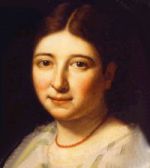Our Lady of Good Counsel
by Zsolt Aradi
The majesty of the Roman countryside has remained unchanged for centuries. Just to the south of the city rise the famous Castelli Romani, the Roman Castles, the popular name given to the hills and townships in Rome's immediate neighborhood. These hills are studded with the palaces of the once rich nobility of Rome who leave the city whenever the depressive and humid scirocco hits the Eternal City. The Castelli Romani are still a part of Rome, yet once we enter that district around Palestrina, popularly called Ciociaria, we are in a different world. Not only is the dialect different from that of Rome, but also the customs, the habits and even the pride of the people. Genazzano is a little town about thirty miles southeast of Rome. One of its characteristics is the stubborn tenacity of the townspeople. This inherited characteristic of the inhabitants of Genazzano played a great part in achieving fame for the city in the Middle Ages.
Genazzano had an unusual importance as early as the fifth century. Large parts of the revenue from this town were given by Pope Sixtus III to the shrine of Our Lady of the Snows, in Santa Maria Maggiore in Rome. In return Genazzano received a new church. That quarter of the town, which had provided the funds for the Church of Our Lady of the Snows was endowed with another church dedicated to Our Lady of Good Counsel. For some reason, however, with the passage of time this church fell into disrepair and even the fact of its dedication to Our Lady was almost forgotten. During those years, toward the end of the fifteenth century, Italy was a battlefield. And the situation was not essentially different in the rest of Europe; the Turks were already on the Balkan Peninsula, threatening to destroy the flourishing civilization there; in fact, nowhere in the West was there any semblance of unity.
It happened that in 1467 a widow and native of Genazzano named Petruccia de Geneo, inspired by Our Lady, decided to rebuild the decrepit church. The townsfolk, knowing that she had no resources, laughed at her. It is true that they did help to build a church as long as she could provide some meager funds. But the moment she ran out of money, they refused their aid. The widow was even forbidden by Church authorities to carry out such a presumptuous dream. Everything seemed to be lost to her and to her cause. But she refused to give up. She astonished the townspeople by her unshakeable faith and determination. And on St. Mark's Day, 1467, the very same year, while the entire population participated in a centuries' old public festive carnival, a cloud descended from a sparkling clear sky before the uncompleted church. And the thousands of witnesses discovered, after the cloud had disappeared, that a small picture of Our Lady and the Child had been left on the walls. At the same moment, all the church bells broke out in ringing.
These events and the subsequent facts and investigations were carefully recorded and are still preserved. Pope Paul II sent a French and a Dalmatian bishop to ascertain the facts. The reports of the bishops state that between the end of April and mid-August, 1467, 171 miracles occurred in Genazzano. It is further related that a few days after the miraculous Madonna, or as the populace called her, "The Madonna of Paradise," appeared in their midst, two visitors, Albanians from Scutari, arrived in Genazzano. These men, fleeing from the Turks occupying Albania, related that a few weeks earlier they had seen the identical picture in a church in the Albanian city of Scutari.
The inquiry committee of Pope Paul II discovered two more instances of miraculous nature. One was the picture itself; the painting had been done on a thin layer of porcelain and its thickness was that of an eggshell. No human hand, however skillful, could have removed, unhurt, such a texture from anywhere. And this thin sheet of porcelain or plaster stood and still stands upright, without any support, having only a narrow ledge to rest on. The second evidence was the following: the picture of Our Lady of Good Counsel that had been venerated for centuries at Scutari had indeed disappeared from its church of origin; the commission of inquiry 80 found an empty space of exact dimensions where the picture previously stood, thus confirming the statements of the Albanians.
The Basilica was built at the end of the fifteenth century and the veneration of Our Lady of Good Counsel spread all over the world. The people in Genazzano and all over the rest of Italy and Europe felt that Good Counsel meant what the words indicate. That the rulers and those subject to rulers, governments and governed, should accept the Divine Counsel as expressed in the Gospel. The people of Genazzano commemorate the day of the appearance of the Madonna of Paradise each spring with a world-renowned procession of spectacular color and beauty. The shrine has been visited by hundreds of thousands and it has remained unchanged and unharmed during the last five hundred years. During World War II, however, a bomb fell on the Basilica housing the miraculous image. It crushed the roof and exploded on the floor of the sanctuary. Many altars, including the main altar, literally disappeared. The walls of the church fell in amid plaster and dust; ancient paintings fell to ruins in the destruction. But behold: the image of Our Lady of Good Counsel, which stood within a few yards of the explosion, remained intact and unshaken. Two scars lined her face, like those on the features of the Madonna of Czestochowa in Poland.
This item 3045 digitally provided courtesy of CatholicCulture.org






